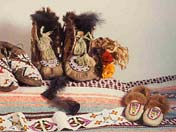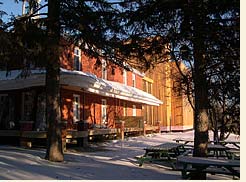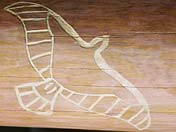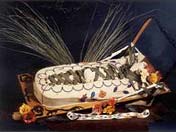

|
 |
|||
| the collective memory of a valiant nation - Pierre Thibault, architect of emotions - Abenakis Museum, a place of fervour - Council of the Great Fire, a Wabanaki perspective | |||
| I was little, he was old. Like all Catholic children on the reserve, he had attended the community's collège. I discovered it at the age of 6 when we were buying a little wigwam as a souvenir of a visit to the Museum with my parents. My grandfather had aged and I had too. He and his father personally took part in establishing this museum, like several other members of the nation. This place has continued to nourish and shape Abenaki identity for several generations. It is with pride that we can find the legacy of our ancestors in the museum, from hand-made objects to old photos exhibited there. We feel at home there and happy because we are full of wonder at the splendour of our culture, too often ignored and always under threat. Our nation has experienced hard times and despite that, it remains important to preserve, protect and promote our Abenaki heritage. The Museum has played an essential role in this mission for over 40 years. When the question of expanding our building arose, most of us didn't believe in it. A handful of individuals, with this dream in their heads and a commitment to build on the dream, achieved the impossible by creating a new facility worthy of our nation: modern and accessible. A completely transformed space presents our origins in a new way. Visitors' experience will be entirely unlike what we had been accustomed to. Where there had been old, dark narrow corridors, now we will walk through a great hall with abundant natural light and then discover the new exhibition spaces. This expansion will allow us to encourage the interest of many people in our culture and identity. It will also encourage youth to meet there as they discover the fascination of visitors from outside. This place bears witness to a long past while it is a place for newcomers' artistic expression. Our attachment to this place is born from the mystery surrounding our people that has endured through centuries. The future is filled at once with hopes and uncertainty. A nation with no school must count on the Museum now to provide access to our ancestors' culture. This little wigwam, which spurred my imagination so much, still holds a significant place among my souvenirs. Although my grandfather has passed away, I am certain that he will be among us at the official opening. Our ancestors passed an (immaterial) heritage on to us that a visit to the Museum can fully convey. Jean-François D. O'Bomsawin |

|
||
 The architectural success
of the Abenakis Museum is the consequence of talent and experience. Pierre Thibault shows with force the distinctive features that make up his work: opening onto the landscape, breathing room for the elements of the whole as well as the transparency and the flexibility of the spaces. The architectural success
of the Abenakis Museum is the consequence of talent and experience. Pierre Thibault shows with force the distinctive features that make up his work: opening onto the landscape, breathing room for the elements of the whole as well as the transparency and the flexibility of the spaces.
The Abenakis Museum is a work of emotions. The links between past and present, interior and exterior as well as between vernacular and modern architecture have a subtle impact on our perceptions of space and time. Visitors to the museum, if they take an interest in dialogue with their surroundings, will emerge transformed. Everything will play a part in a sensitive journey, as if we were walking through a forest. The Abenakis Museum is a place of memory but also and above all open to the future, and a place filled with the possibilities of a living culture. |
|||
| Several examples throughout the world bear witness to the concrete impact opening a quality cultural space can have on a city or a community. Since its April opening, the Grande Bibliothèque in Montreal has proven to be a great hit and this shows no sign of letting up. The new Abenakis Museum, which will officially open its doors next fall, is a remarkable instrument for conservation and cultural promotion that will also prove successful. Everything has been designed to spotlight the cultural and spiritual universe of the Abenakis in a contemporary perspective so current and future generations will find the resources they need to flourish. Our museum will play a part in showcasing the place of First Peoples of North America in the history of the continent and their essential contribution to the world cultural and artistic heritage. The need to ensure the young generations in Abenaki communities their own means of development ads another facet to the museum's role. The Abenakis Museum is a key player in the cultural, social and economic milieus of the Abenaki nation. It goes without saying that the conclusion of this marvellous project is itself a strong sign of the confidence a people can have in its future. And it is above all an invitation to the rest of the world to discover this unique place on the river where a nation has chosen to affirm its members' creativity with vitality and respect. |
|||
| Fire plays many roles, both practical and symbolic. We unite around the fire to eat, to warm ourselves and to converse and listen to tales and legends. We also encounter allies there to deal with the nation's business. This was the case for the member nations of the Council of the Great Fire, the old alliance of Northeastern Aboriginal peoples. This alliance brought together nations from the Atlantic coast to the Great Lakes. Connected to each other by a trade network based on sharing and diplomacy, these nations' representatives succeeded in preserving the spirit of alliance for many years thanks to the wampum tradition. During summer 2005, the Abenakis Museum will bring the Council of the Great Fire back to life. Come celebrate the time of alliances with us at Odanak! |
 |
||

